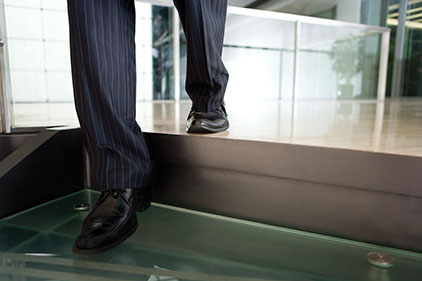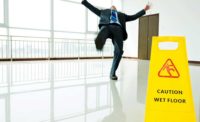It is because of these staggering figures that the National Floor Safety Institute (NFSI) says OSHA has released a new ruling, Subpart D of 29 CFR part 1910. This new ruling is designed to promote worker safety in all locations, including industrial-type locations, as well as establish standards and levels of responsibility that supersede past OSHA regulations. Industrial facility administrators will note some changes to the terms and terminology used to discuss floor safety.
For instance, traditionally OSHA said employers must maintain floors that are “slip resistant.” This term is set to be phased out, replaced by the term “high traction.” Many chemicals used to finish floors, as well as work shoes, used the term slip-resistant to describe products designed to prevent slips, trips and falls. However, due to technical advances and more precise measurement techniques, it was determined that the term “high traction” was more appropriate to describe these products.
Before discussing some other changes in the new ruling, we should have a clear understanding as to how floors are measured for slip resistance. Going back almost a century, cleaning workers developed a system, referred to as the “bean bag test,” to measure how slippery a floor is. A 10-pound bag of beans was attached to a spring scale. If there was six pounds of pull, the floor was determined to be safe. If there was less than six pounds — meaning there was little friction — the floor was judged to be unsafe.
This same principal is the basis for a machine called a tribometer, frequently used today. A tribometer measures the coefficient of friction of a floor (COF). Like the bean bags, it is pulled over the floor to measure friction. However, unlike the bean bags, it can precisely rate the floor’s COF. A COF of 0.5 to 0.6 is the desired rating for safety.*
Qualified inspections
One big change in the new OSHA regulations is the requirement that facilities be audited for floor safety by a “qualified person.” According to OSHA, a qualified person is defined as being “any person designated by the employer who is knowledgeable about and familiar with all relevant manufacturers’ specifications and recommendations; is capable of identifying existing or potential hazards in specific surroundings or working conditions which may be hazardous or dangerous to employees; and has been trained for the specific task assigned. When work is to be supervised by a qualified person, the qualified person shall have the necessary authority to carry out the assigned work responsibilities.”
Employers can designate a qualified person working in the facility, an outside vendor, or a cleaning professional. Whoever is selected must receive specific training on floor care safety. Such non-profit organizations as the NFSI are now providing this training.
Typically such qualified experts are called in after an accident has occurred. OSHA wants to turn that around by having the floor inspected before an accident can occur. According to the NFSI, the mandate makes it clear that this audit of the floors is required for all facilities, and each must inspect walkways and hard surface work areas to ensure they are in compliance.
Cleaning issues
Cleaning and housekeeping also play a major role in the new ruling. Says Russell J. Kendzior, founder of the NFSI, “an effective housekeeping program including floor care,” will be necessary for building and business owners to meet the requirements of the new OSHA rulings. This may require many industrial locations to re-evaluate their entire floor maintenance procedures because those programs — especially if they involve mops — may be increasing the possibility of a slip and fall accident occurring.
One reason is that many hard surface floors are dust mopped regularly, sometimes many times during the day. Usually cleaning professionals treat the dust mop with an oil treatment to help capture dust and debris on the floor. However, over time, this can cause what is called a “degree of damage or change” to the floor, causing the COF to be reduced and increasing the chances for a slip and fall to occur.
To prevent this, the use of oil-treated dust mops is not recommended. What can prove very effective in many situations is to avoid dust mopping at all. If possible, using a new generation of backpack vacuum cleaners or industrial vacuum cleaners may more effectively clean floors without impacting the floor’s COF.
Another issue involves wet mopping the floor. The wet mop becomes soiled very quickly. The more it becomes soiled — along with the cleaning solutions — the less effective the mopping process becomes; the process can actually spread soils. Studies published by the Centers for Disease Control and Prevention (CDC) found in such cleaning situations “contamination is transferred [from the old surface] to the new surface” being cleaned. When this happens, a slippery residue or film is left on the floor, and this too can cause a “degree of damage or change” to the floor.
It is best to look for other floor cleaning options that do not involve mopping. One of the least costly but very effective systems is to simply use a trolley bucket instead of a traditional floor cleaning bucket, according to Matt Morrison, communications manager with Kaivac, Inc., manufacturer of professional cleaning equipment. “With a trolley bucket, fresh cleaning solution is dispensed directly to the floor from a spigot under the bucket. The mop is never inserted into the bucket [and] the floor can then be cleaned using a deck brush, a squeegee to remove moisture, or a microfiber flat mop instead of a traditional floor mop.”
Taking this a step further, Morrison adds that with some trolley bucket systems additional components can be added such as a wet vacuum unit with a bucket-mounted or wand-mounted squeegee head. With these added components, after the solution is spread over the floor and brushed as needed, the floor can then be vacuumed to remove all moisture as well as dust, debris and soil.
Cost factors
If an employee is injured and it is found that it was caused by something that could have — and should have — been corrected, liability costs can be staggering. It is far better and far cheaper to make sure the slip and fall does not occur in the first place. And when you look at the new ruling in greater detail, you realize this is actually its goal.
* Note: Too high a COF can be as dangerous as too low a COF. If the COF is too high, the floor may be tacky, making walking difficult that could result in a slip, trip or fall.

